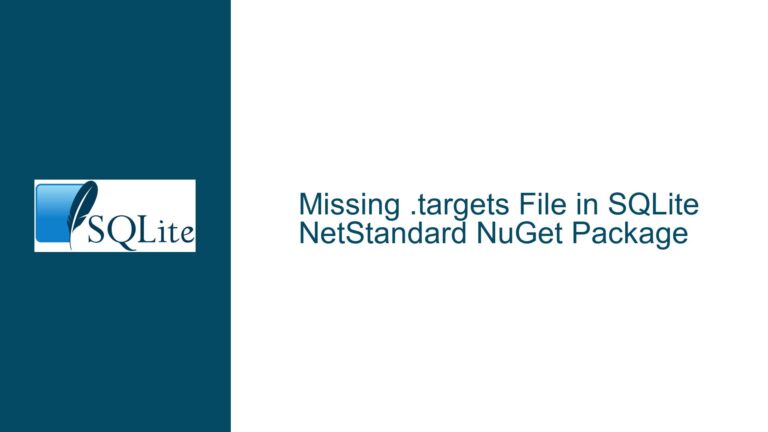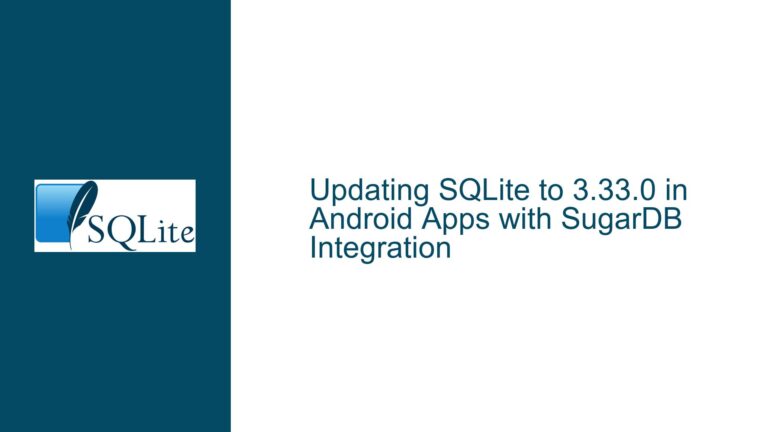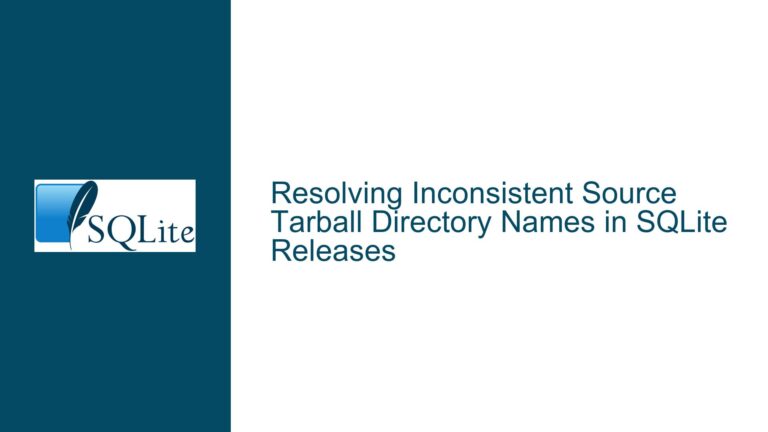Memory Allocation Issues in SQLiteDataReader Close and Dispose
Memory Allocation Overhead in SQLiteDataReader Event Handling
When working with SQLite databases using the System.Data.SQLite library, one of the critical performance bottlenecks that can arise is related to memory allocation during the Close and Dispose methods of the SQLiteDataReader. Specifically, the creation of ConnectionEventArgs and its associated data array can lead to significant memory overhead, even when no event subscribers are present. This issue is particularly pronounced in workloads that involve frequent database operations, where the cumulative effect of these allocations can account for a substantial portion of both memory usage and CPU time.
The ConnectionEventArgs object is typically instantiated to facilitate event-driven communication within the SQLiteDataReader, particularly for events like StateChange or InfoMessage. However, when no event handlers are registered, the allocation of these objects becomes redundant and wasteful. This inefficiency is exacerbated in high-throughput scenarios, where the constant creation and disposal of these objects can lead to increased garbage collection pressure and reduced application performance.
Understanding the root causes of this behavior requires a deep dive into the internal workings of the SQLiteDataReader and the event handling mechanisms within the System.Data.SQLite library. By examining the lifecycle of the SQLiteDataReader and the conditions under which ConnectionEventArgs are created, we can identify potential optimizations that mitigate these inefficiencies without compromising the functionality of the library.
Root Causes of Redundant Memory Allocations
The primary cause of the observed memory allocation overhead lies in the unconditional creation of ConnectionEventArgs objects within the SQLiteDataReader‘s Close and Dispose methods. These methods are designed to ensure that resources are properly released and that any pending events are raised before the reader is finalized. However, the current implementation does not account for the possibility that no event handlers may be registered, leading to unnecessary allocations.
The ConnectionEventArgs object is typically instantiated with a data array that contains information about the connection state or other relevant details. This data array is allocated regardless of whether any subscribers are listening for the corresponding events. In scenarios where no event handlers are present, this results in a wasteful allocation of memory that serves no practical purpose.
Another contributing factor is the lack of lazy initialization or conditional creation of these event arguments. In many event-driven architectures, event arguments are only created when there are active subscribers. This approach minimizes memory overhead by avoiding the allocation of objects that will never be used. However, the current implementation of the SQLiteDataReader does not employ this optimization, leading to the observed inefficiencies.
Additionally, the frequency of Close and Dispose calls in a typical database workload exacerbates the problem. Each call to these methods results in the creation of a new ConnectionEventArgs object, even if the previous one was immediately discarded. This pattern of frequent allocation and deallocation can lead to fragmentation of the managed heap, further increasing the memory footprint and garbage collection overhead.
Mitigating Memory Allocation Overhead in SQLiteDataReader
To address the memory allocation overhead in the SQLiteDataReader‘s Close and Dispose methods, several strategies can be employed. These strategies aim to reduce or eliminate the unnecessary creation of ConnectionEventArgs objects while maintaining the functionality and reliability of the library.
One effective approach is to implement lazy initialization of ConnectionEventArgs. This involves creating the event arguments only when there are active subscribers to the corresponding events. By deferring the allocation until it is actually needed, we can significantly reduce the memory overhead in scenarios where no event handlers are registered. This can be achieved by introducing a check for active subscribers before instantiating the ConnectionEventArgs object.
Another optimization is to reuse ConnectionEventArgs objects where possible. Instead of creating a new instance for each Close or Dispose call, we can maintain a pool of pre-allocated event arguments that can be reused across multiple operations. This approach reduces the frequency of allocations and can help mitigate the impact on the managed heap. However, care must be taken to ensure that the reused objects are properly reset and do not retain stale data from previous operations.
In addition to these optimizations, it is important to review the overall design of the event handling mechanism within the SQLiteDataReader. By analyzing the usage patterns and identifying which events are most frequently raised, we can prioritize optimizations for the most critical paths. For example, if certain events are rarely used, we can consider removing them entirely or making them opt-in to further reduce overhead.
Finally, thorough testing and profiling are essential to validate the effectiveness of these optimizations. By comparing the memory usage and performance metrics before and after implementing the changes, we can ensure that the optimizations achieve the desired results without introducing new issues. This iterative process of analysis, optimization, and validation is key to maintaining the performance and reliability of the System.Data.SQLite library.
Detailed Analysis of SQLiteDataReader Event Handling
To fully understand the impact of the memory allocation overhead in the SQLiteDataReader, it is necessary to delve into the specifics of how event handling is implemented within the class. The SQLiteDataReader is designed to provide a high-level interface for executing SQL commands and retrieving results from an SQLite database. As part of its functionality, it raises various events to notify consumers of changes in the connection state or other significant occurrences.
The ConnectionEventArgs class is a custom event argument type that encapsulates information about these events. It typically includes properties such as the connection state, the SQL command being executed, and any relevant error messages. When an event is raised, an instance of ConnectionEventArgs is created and passed to the event handlers. This allows the handlers to access the relevant information and take appropriate action.
However, the current implementation of the SQLiteDataReader creates these event arguments unconditionally, regardless of whether any event handlers are registered. This means that even in scenarios where no consumers are listening for these events, the ConnectionEventArgs object and its associated data array are still allocated. This behavior is inefficient and can lead to significant memory overhead, particularly in high-throughput scenarios.
To illustrate this issue, consider a typical database operation where a SQLiteDataReader is used to execute a query and retrieve results. During the execution of the query, the SQLiteDataReader may raise multiple events, such as StateChange or InfoMessage. Each of these events results in the creation of a new ConnectionEventArgs object, even if no event handlers are registered. Over the course of many such operations, the cumulative effect of these allocations can become substantial.
Profiling and Identifying Memory Allocation Hotspots
Profiling is an essential tool for identifying and quantifying the impact of memory allocation overhead in the SQLiteDataReader. By using a profiler such as dotTrace, we can capture detailed information about the memory allocations and CPU usage associated with the Close and Dispose methods. This data provides valuable insights into the specific areas where optimizations can be most effective.
In the case of the SQLiteDataReader, profiling reveals that a significant portion of the memory allocations are attributed to the creation of ConnectionEventArgs objects. These allocations account for approximately two-thirds of the total memory usage in some workloads, making them a prime target for optimization. Additionally, the CPU time spent on these allocations can account for around 10% of the total execution time, further highlighting the importance of addressing this issue.
By analyzing the profiling data, we can identify the specific methods and code paths responsible for these allocations. This allows us to focus our optimization efforts on the most critical areas, ensuring that we achieve the greatest impact with the least amount of effort. For example, if the profiling data shows that a particular event is responsible for a disproportionate amount of allocations, we can prioritize optimizing the handling of that event.
Implementing Lazy Initialization for ConnectionEventArgs
One of the most effective strategies for reducing memory allocation overhead in the SQLiteDataReader is to implement lazy initialization for ConnectionEventArgs. This approach involves deferring the creation of the event arguments until they are actually needed, rather than creating them unconditionally. By doing so, we can avoid the unnecessary allocations that occur when no event handlers are registered.
To implement lazy initialization, we can modify the SQLiteDataReader to check for active subscribers before creating the ConnectionEventArgs object. This can be done using the GetInvocationList method of the event delegate, which returns an array of all registered event handlers. If the array is empty, we can skip the creation of the event arguments altogether.
Here is an example of how this optimization can be implemented in C#:
private void RaiseConnectionEvent(ConnectionEventType eventType, string message)
{
var handlers = ConnectionEvent?.GetInvocationList();
if (handlers != null && handlers.Length > 0)
{
var eventArgs = new ConnectionEventArgs(eventType, message);
ConnectionEvent?.Invoke(this, eventArgs);
}
}
In this example, the RaiseConnectionEvent method first checks if there are any registered event handlers by examining the GetInvocationList of the ConnectionEvent delegate. If there are no handlers, the method returns immediately without creating the ConnectionEventArgs object. This simple change can significantly reduce the memory overhead in scenarios where no event handlers are present.
Reusing ConnectionEventArgs Objects to Reduce Allocations
Another optimization strategy is to reuse ConnectionEventArgs objects across multiple event invocations. Instead of creating a new instance for each event, we can maintain a pool of pre-allocated event arguments that can be reused. This approach reduces the frequency of allocations and can help mitigate the impact on the managed heap.
To implement object reuse, we can introduce a pool of ConnectionEventArgs objects that are created once and then reused as needed. When an event is raised, we retrieve an event argument from the pool, update its properties, and pass it to the event handlers. After the event has been handled, the event argument is returned to the pool for future use.
Here is an example of how this optimization can be implemented in C#:
private readonly ObjectPool<ConnectionEventArgs> _eventArgsPool = new ObjectPool<ConnectionEventArgs>(() => new ConnectionEventArgs());
private void RaiseConnectionEvent(ConnectionEventType eventType, string message)
{
var handlers = ConnectionEvent?.GetInvocationList();
if (handlers != null && handlers.Length > 0)
{
var eventArgs = _eventArgsPool.Get();
eventArgs.EventType = eventType;
eventArgs.Message = message;
ConnectionEvent?.Invoke(this, eventArgs);
_eventArgsPool.Return(eventArgs);
}
}
In this example, the RaiseConnectionEvent method retrieves a ConnectionEventArgs object from the pool using the Get method of the ObjectPool class. The event argument is then updated with the relevant information and passed to the event handlers. After the event has been handled, the event argument is returned to the pool using the Return method.
This approach reduces the number of allocations by reusing event arguments across multiple invocations. However, it is important to ensure that the reused objects are properly reset and do not retain stale data from previous operations. This can be achieved by implementing a reset mechanism in the ConnectionEventArgs class or by manually resetting the properties before returning the object to the pool.
Evaluating the Impact of Optimizations on Performance
After implementing the optimizations described above, it is crucial to evaluate their impact on the performance of the SQLiteDataReader. This involves profiling the application to measure the reduction in memory allocations and CPU usage, as well as assessing any potential trade-offs or side effects.
Using a profiler such as dotTrace, we can capture detailed metrics before and after applying the optimizations. This allows us to quantify the reduction in memory overhead and CPU time, providing concrete evidence of the effectiveness of the changes. Additionally, we can monitor the application for any changes in behavior or performance that may arise as a result of the optimizations.
In the case of the SQLiteDataReader, the optimizations are expected to result in a significant reduction in memory allocations, particularly in scenarios where no event handlers are registered. The CPU time spent on these allocations should also decrease, leading to improved overall performance. However, it is important to ensure that the optimizations do not introduce new bottlenecks or degrade the functionality of the library.
Best Practices for Event Handling in High-Performance Applications
The issues encountered with the SQLiteDataReader highlight the importance of careful design and optimization when implementing event handling in high-performance applications. By following best practices, developers can minimize the overhead associated with event-driven communication and ensure that their applications remain efficient and responsive.
One key best practice is to use lazy initialization for event arguments, as described earlier. This approach ensures that event arguments are only created when they are actually needed, reducing unnecessary allocations. Additionally, developers should consider reusing event arguments where possible, using techniques such as object pooling to further reduce memory overhead.
Another important consideration is the frequency and granularity of events. In high-performance applications, it is often beneficial to minimize the number of events raised and to aggregate related information into fewer, more comprehensive events. This reduces the overall overhead associated with event handling and can lead to significant performance improvements.
Finally, thorough testing and profiling are essential to identify and address performance bottlenecks in event handling. By regularly profiling the application and analyzing the results, developers can ensure that their optimizations are effective and that the application remains performant under a variety of workloads.
Conclusion
The memory allocation overhead in the SQLiteDataReader‘s Close and Dispose methods is a significant performance bottleneck that can impact the efficiency of applications using the System.Data.SQLite library. By understanding the root causes of this issue and implementing targeted optimizations, developers can reduce the memory overhead and improve the overall performance of their applications.
Key strategies for addressing this issue include lazy initialization of ConnectionEventArgs, reuse of event arguments through object pooling, and careful design of the event handling mechanism. These optimizations, combined with thorough testing and profiling, can lead to substantial improvements in memory usage and CPU time, ensuring that the SQLiteDataReader remains a reliable and efficient tool for database operations.
By following best practices for event handling in high-performance applications, developers can minimize the overhead associated with event-driven communication and ensure that their applications remain responsive and efficient. The lessons learned from optimizing the SQLiteDataReader can be applied to other areas of application development, leading to more robust and performant software solutions.






